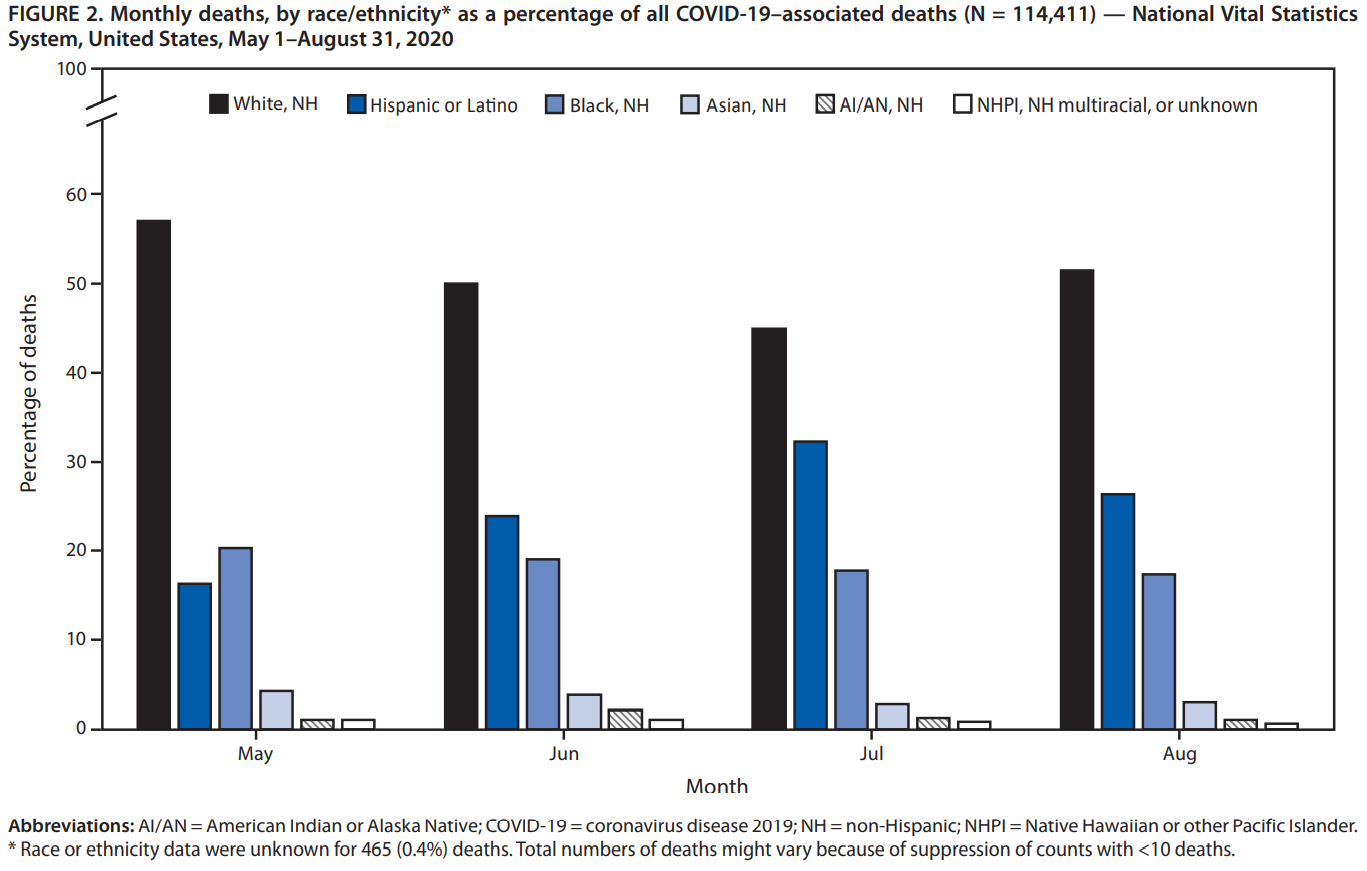The chosen research was conducted by a collective of seventeen people. The majority operates under CDC COVID-19 Emergency Response: Jayme Coyle; Brittney N. Baack; Tonji M. Durant; Kenneth L. Dominguez; S. Jane Henley; Francis B. Annor; Jennifer Fuld; Deborah L. Dee; Achuyt Bhattarai; Brendan R. Jackson. The following authors also fall under Epidemic Intelligence Service’s jurisdiction, CDC: Jeremy A.W. Gold; Phillip P. Salvatore; Jennifer DeCuir. The following three people work for National Center for Health Statistics, CDC: Lauren M. Rossen; Farida B. Ahmad; Paul Sutton. Finally, Zeyu Li is an employee of NYC Health + Hospitals.
The article analyzes deaths due to COVID-19 from the perspective of race, ethnicity, and age of its victims. It builds upon the already known information about deaths associated with the disease – the age (sixty-five years and older) and racial and ethnic disproportional representation (Gold et al., 2020). Consequently, it analyses over a hundred thousand COVID-19 associated deaths reported from May to August 2020 to the National Vital Statistics System. The results show the proportional representation of non-Hispanic White, Hispanic or Latino, non-Hispanic Black, and other descendants – it is approximately fifty-one, twenty-four, and nineteen percent accordingly (Gold et al., 2020). In addition, the analysis indicated a ten percent growth in deaths of Hispanic descendants during the chosen time (Gold et al., 2020). Overall, the primary purpose of the research was to address the mortality issue by adequately adjusting the public health messaging and infection prevention and early detection among affected population groups.

The type of study used in the article is qualitative. According to Holmes et al. (2017), qualitative data focus on categorizing specific population attributes, such as hair color, blood type, or any data that generally can be expressed in words or letters. As mentioned in the article’s title, the study analyses race, ethnicity, and age of COVID-19 victims. Since the attribute of age is marked by researchers as “already known” information, the study’s consequent focus on race and ethnicity makes it qualitative.
For this lab, I have chosen to analyze a histogram type. Histograms can be categorized as a series of adjoining boxes, usually used to describe the data sets consisting of over one hundred samples (Holmes et al., 2017). Its horizontal axis represents the chosen data, in this case – the certain months from the given period. In the meantime, the vertical axis presents the percentage of specific racial or ethnic occurrences in the chosen data set. Researchers decided to introduce a separate histogram for each month selected for better transparency. Since the purpose of the histogram, in this case, is to show the percentage of specific races among the deaths due to disease, the horizontal axis becomes less relevant. Thus, the class width of each histogram is not taken into account. The total sample size is 114,411, with a total frequency of one hundred percent; the distribution displayed is left-skewed. Because this histogram represents the statistics and is not part of an experiment, explanatory and response variables may be omitted.
In the context of the article, the histogram shows the disproportion in the representation of minority groups compared to the White population. According to Gold et al. (2020), Hispanic and non-Hispanic Black minorities represent approximately nineteen and thirteen percent of the total U.S. population accordingly. However, minority representation in the deaths sample showcases almost a quarter for Hispanic and nineteen percent for non-Hispanic Black minorities (Gold et al., 2020). This tendency indicates the increased risk of minorities’ exposure to the COVID-19 virus. Gold et al. (2020) imply that the reasons behind such tendencies lie in the geographical shift of the disease spread, as well as specific social inequities in the U.S. The differences in social health determinants, such as, for example, life in the households consisting of multiple families or congregate environments with limited access to health care, increase the risk of the exposure. In addition, specific prevalences of various underlying conditions, such as obesity or diabetes, might also contribute to the increased susceptibility to fatal exacerbations associated with COVID-19.
The data set chosen for this research could be displayed in a table. Tables’ main strength is the ability to showcase essential numbers regarding the selected issue; usually, they tend to be a good choice for quantitative analysis (Holmes et al., 2017). Nevertheless, despite them providing better numerical representation than a histogram, they lack the visual representation feature, which might be more impactful in the given matter. The frequency polygons also present a viable option for representing racial and ethnic features in the total deaths sample. Analogically to line graphs, frequency polygons make interpreting continuous data visually effortless – their plot connects the data points with line segments resembling the continuity (Holmes et al., 2017). However, in this article, researchers decided to divide the total sample size into four months for the sake of transparency and ease of comparison. Thus, four frequency polygons presented in one graph would not achieve the same visual effect as histograms.
References
Gold, J., Rossen, L. M., Ahmad, F. B., Sutton, P., Li, Z., Salvatore, P. P., Coyle, J. P., DeCuir, J., Baack, B. N., Durant, T. M., Dominguez, K. L., Henley, S. J., Annor, F. B., Fuld, J., Dee, D. L., Bhattarai, A., & Jackson, B. R. (2020). Race, ethnicity, and age trends in persons who died from COVID-19 – United States, 2020. MMWR. Morbidity and mortality weekly report, 69(42), 1517–1521. Web.
Holmes, A., Illowsky, B., & Dean, S. (2017). Introductory business statistics. Rice University.